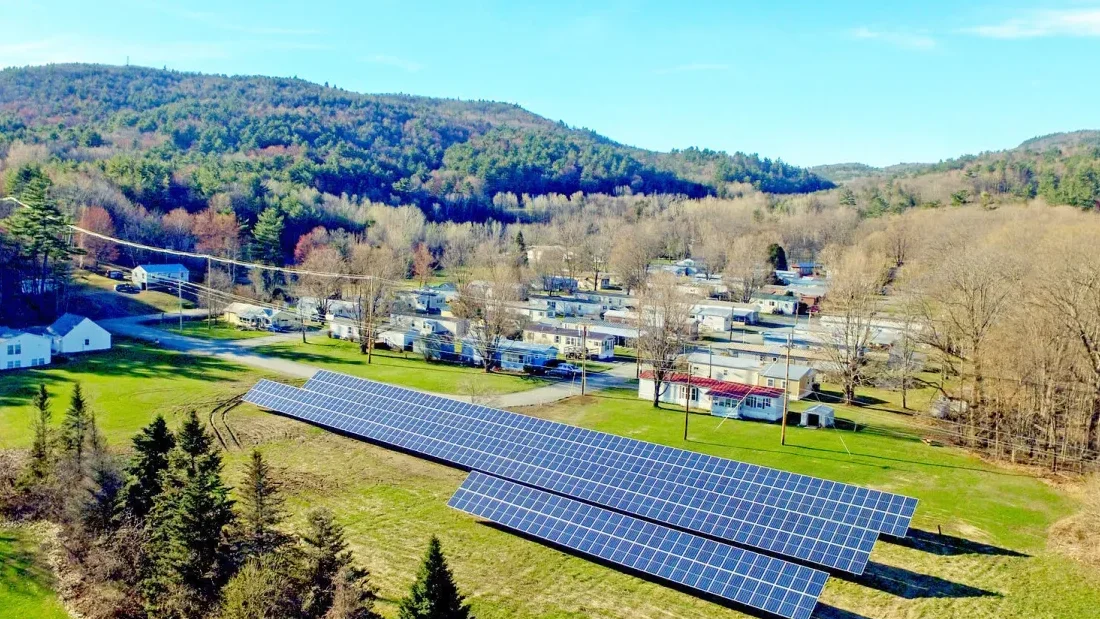
CLIMATE: Clean electricity standards enacted in Minnesota and Michigan bookended a year of state-level climate progress that included gas hookup restrictions and new funding for clean energy manufacturing. (E&E News)
OIL & GAS:
ELECTRIC VEHICLES:
EMISSIONS: The U.S. Supreme Court will hear a challenge to the U.S. EPA’s anti-air-pollution “good neighbor” rule that limits power plant emissions that drift into other states. (Associated Press)
WIND:
SOLAR: A California appeals court rejects a petition to overturn a new state policy cutting compensation for rooftop solar; petitioners say they may take the case to the state Supreme Court. (San Diego Union-Tribune)
UTILITIES: North Carolina regulators consider Duke Energy’s green tariff proposal, which would allow the utility to count customers’ renewable energy purchases toward compliance with its state carbon emission goals. (Energy News Network)
CLEAN ENERGY: A Minnesota agency overseeing the state’s clean energy transition adds 64 positions to its staff of roughly 90 to help manage new state programs and capitalize on federal funding opportunities. (Energy News Network)
FINANCE: Industry analysts say cleantech investing is poised for a strong 2024 after a slow start to 2023 rebounded in the second half of the year. (Canary Media)
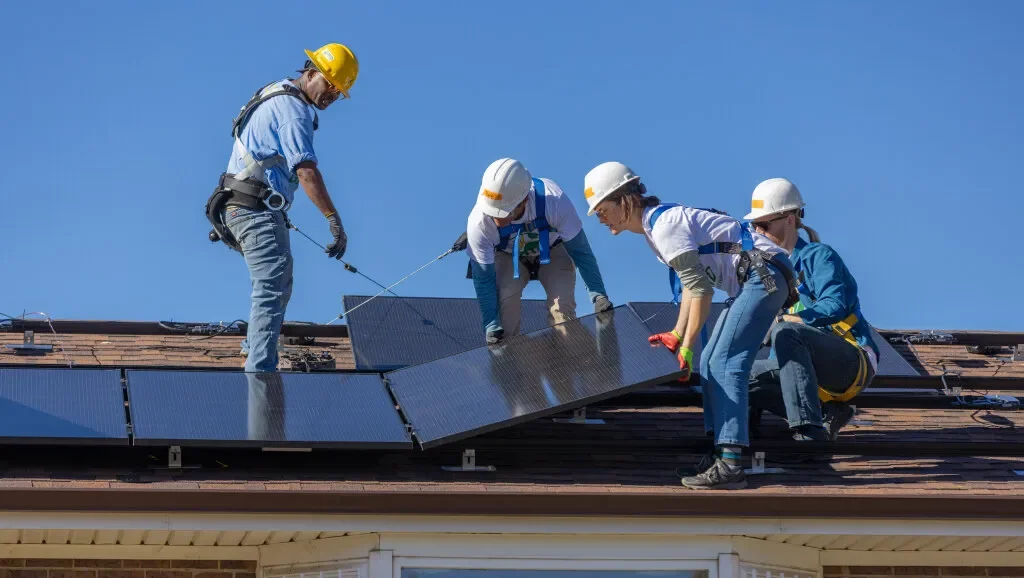
SOLAR: A California appeals court rejects a petition to overturn a new state policy cutting compensation for rooftop solar; petitioners say they may take the case to the state Supreme Court. (San Diego Union-Tribune)
ALSO: A survey finds California’s solar industry has lost about 17,000 jobs since regulators slashed net metering rates for residential installations. (news release)
CLEAN ENERGY:
ELECTRIFICATION: A small Colorado town’s proposal to decarbonize buildings by banning natural gas hookups in new construction runs up against the nation’s largest natural gas-only utility’s opposition and political power. (NPR)
UTILITIES: Wyoming regulators approve a 5.5% Rocky Mountain Power rate hike after the utility admits its proposed 29.2% increase was partly based on a major accounting error. (WyoFile)
STORAGE: An Arizona utility brings a 100 MW battery energy storage system online in the southern part of the state. (Renewable Energy World)
TRANSITION: Northwestern New Mexico economic development officials seek $100 million in state funds to expand the fossil fuel-reliant region’s energy economy by creating a hydrogen production hub. (Farmington Daily Times)
CLIMATE:
COAL: A Utah coal mine that has been on fire since last year is “idled indefinitely” and plans to lay off its remaining 150 employees in January. (Salt Lake Tribune, subscription; Argus Media)
CARBON CAPTURE: The U.S. EPA publishes draft injection well permits for sequestering carbon dioxide from a hydrogen production facility in southern California, the agency’s first for the state. (E&E News, subscription)
HYDROPOWER: A Colorado organization acquires Colorado River water rights from an Xcel Energy hydropower plant in an innovative $100 million deal. (Aspen Journalism)
NUCLEAR: The Columbia nuclear power plant in Washington state completes its initial 40-year operating phase with plans to continue to keep operating at least until 2043. (Tri-City Herald)
OIL & GAS: Federal analysts predict natural gas prices will remain low through the winter, digging into tax revenues in gas-producing states like Wyoming. (Oil City News)
BIOFUELS: California awards $4 million to planned bioenergy facilities that will burn forest restoration waste to generate power. (Biofuels Digest)

One of the primary state agencies that oversees Minnesota’s climate and clean energy programs is expanding its staff by nearly two-thirds, fueled by new state and federal funding opportunities.
The Minnesota Department of Commerce’s Division of Energy Resources, which plays a central role in Minnesota’s clean energy transition, has added 64 positions to its roughly 90 employees at the start of the year. Of those positions, 42 have been filled and 22 are in the hiring process.
The department oversees programs related to energy conservation, solar for schools and colleges, weatherization, energy assistance and other associated areas.
The hiring spree is being paid for with new funding from state and federal legislation. The Legislature created seven new energy-related programs this spring, including rebate efforts, a $100 million state competitiveness fund and a green bank. The Division of Energy Resources will manage the new programs, which are expected to begin next year.
“We anticipate that as various programs are set up, we may need additional staffing to support those efforts,” said Michelle Gransee, a deputy commissioner who oversees the division.
Some of the new hires are already helping bring in additional federal dollars to the state. Since July, the division has secured over hundreds of millions of dollars in new funding for utilities and communities under the Inflation Reduction Act and other programs.
“Bringing in hundreds of millions, if not billions of dollars, requires dedicated staffing,” Gransee said.
Employees will fill out new and existing roles after a department restructuring that added new sections to deal with responsibilities created by lawmakers in the 2023 session, the most productive for energy legislation in Minnesota history. Other hires will assist in funding that has come through the Inflation Reduction Act and other federal laws.
The surge in new employees is the largest Gransee has seen in her 14-year Commerce career. The only comparable period came in 2009 when the American Recovery and Reinvestment Act funded money for clean energy, but that lasted just two years.
The division has been hiring program developers, economists, lawyers, engineers, building science specialists, and grants and contracts experts, to name a few.
“We’re bringing in a diversity of talent and experience, which we were thrilled to see,” Gransee said.
The division has been receiving applications from employees of other state agencies, as well as recent University of Minnesota graduates, and people with backgrounds in nonprofits, utilities, and think tanks. The state has used LinkedIn and other regional and national experts to cast a net beyond Minnesota. Many applicants, she said, have been attracted to working at Commerce because they can have a direct impact on mitigating climate change in the state.
Among the recent higher profile hires have been Pete Klein, former vice president of finance at the St. Paul Port Authority, who planned to retire before being offered the opportunity to lead the department’s Minnesota Climate Innovation Finance Authority. With a budget of $45 million, the climate innovation authority, also known as a green bank, will develop financing tools to leverage private investment.
The department also recently hired John Michael-Cross, formerly a project manager with the Washington, D.C.-based Environment and Energy Study Institute, to run the state’s community solar program. In 2023, the Legislature moved management of the program from Xcel Energy to the state division.
Gransee said not all new employees will be permanent. Several will work under contract and not become employees.
“The tradition of coming into the state and working for the next 40 years for it isn’t for everybody,” she said. “For some, it’s exciting to come into a position that’s two or three years long, have a great impact, and then see what’s next.”
The Division of Energy Resources has recently expanded with more than 30 new programs that will be managed by the following offices:
“Each of those offices has some growth in them,” she said. “Some are entire units; others will have just one additional person coming into a space for a specific project or program.”
Gregg Mast, executive director of the nonprofit Clean Energy Economy Minnesota, said the additional employees will be needed to have “rapid rollout of the new programs so we can have swift implementation.” The advocacy group hopes Commerce’s new staff members will expand private sector clean energy jobs in Minnesota.
Since the legislative session ended, Gransee said agency staff have been occupied with creating new and updating existing programs.
“We’re thrilled by the expansion,” she said. “We could have twice as many staff and still keep everybody busy.”

In the meantime, check out ten of our best Energy News Network stories from the past year, from tackling toxic coal ash in Puerto Rico to electrifying buildings in snowy Maine.
Heating and cooking aren’t the only sources of building emissions: In Massachusetts and beyond, advocates and policymakers are starting to tackle the carbon footprint of all the materials and labor that goes into new buildings.
Detroit resident ‘leads with love’ while laying a foundation for neighborhood climate resiliency: On Detroit’s east side, Tammara Howard is leading efforts to build a network of climate resilience hubs to help residents thrive amid a changing climate.
For tree-sitter, no hiding from heartbreak of deal to greenlight Mountain Valley Pipeline: The federal government’s approval of the contentious Mountain Valley Pipeline brought heartbreak for Theresa “Red” Terry and other Virginia advocates.
Who decides where we get electricity and how much we pay? Mostly White, politically connected men: A pair of studies showed how public utility commissions, which have control over electricity rates and sources, don’t look like the people they represent.
For this immigrant-led clean energy company, perspective is everything: A Chicago-area engineer and CEO with roots in Ghana, Senyo Ador and his Sẽsẽnergi Eco Solutions Enterprise is helping the next generation of energy workers find their footing.
Making Maine’s next generation of housing fossil-free — and affordable: Maine’s population is growing faster than its housing supply, and advocates say that gives the state an opportunity to build out denser, all-electric, energy efficient housing.
In Puerto Rico, residents wait for accountability, cleanup of toxic coal ash ‘caminos blancos’: Two decades after a Virginia-based power company sold toxic coal ash to Puerto Rico towns as a cheap material for road construction, residents are fighting for cleanup and accountability.
With N.C. home efficiency codes frozen, advocates eye other opportunities: After North Carolina’s building industry lobbied to stave off new energy-efficient building codes for years, advocates are looking to federal tax credits and utility incentives to clean up building emissions.
Low-emissions steelmaking could be big business for Minnesota’s Iron Range, experts say: We finished out the year with this collaboration with Minnesota’s KAXE/KBXE, diving into ways the state can clean up its emissions-heavy taconite mining industry.
🤝 COP’s big deal: The COP28 climate summit ends with the first-ever global agreement to begin “transitioning away from fossil fuels,” though some leaders acknowledge the pact is nonbinding and should’ve been reached years ago. (Politico)
🎓 America’s climate report card: Climate and clean energy experts grade U.S. climate progress in 2023, from an A- for clean energy investments to an F for its patent system that keeps critical breakthroughs private. (Grist)
🛢️ Normalizing carbon capture: The rising viability of carbon capture worries climate scientists, who say oil and gas producers could use it as a loophole to keep drilling. (E&E News)
⚡ Sidestepping gas bans: Western cities find innovative ways to push building electrification — such as setting emissions targets and restricting indoor air pollution — that don’t violate a court order prohibiting natural gas hookup bans. (Grist)
🔌 EV charging inconsistencies: Experts say the electric vehicle charger industry faces a big dilemma as it aims to normalize charging standards and software among several manufacturers. (Canary Media)
🧊 DEI efforts stall out: Efforts to diversify environmental organizations appear to have stalled or even lost ground, according to a new analysis, potentially jeopardizing the fight for equitable climate solutions. (Axios)

An effort led by Chicago’s Blacks in Green has been recommended for $12.5 million in renewable energy credits to help develop three community solar projects to benefit underresourced communities.
The three projects totaling 9 MW are valued at $25.7 million and will be developed by the Green Energy Justice Cooperative, a project launched by Blacks in Green and other partners, to benefit Black, Brown and low and moderate-income subscribers in and around Aurora, Naperville, and Romeoville, Illinois. The Illinois Power Agency ranked the projects first, second and fourth among proposals vying for renewable energy credits in the Illinois Shines competition.
Naomi Davis, founder and CEO of Blacks in Green, says the recognition is the culmination of a long effort to ensure energy independence for her community.
“The importance of the industry was made very, very clear to me and others right from the start,” she said. “The opportunity was presenting itself with renewable energy credits that Blacks in Green and others had fought for, for over a decade to really build out the toolkit for the renewable energy industry in Illinois.”
“We’re delighted to partner with Blacks in Green to help create new sources of renewable energy in Aurora and Romeoville through the Green Energy Justice Co-op,” said Vibhu Kaushik, senior vice president and global head of energy, utilities, and storage at Prologis in a news release. “As a member of the local business community, Prologis is focused on working with our customers, local governments, and local partners like Blacks in Green to help create a vibrant and sustainable economy.”
Launched in 2022, the Green Energy Justice Cooperative, or GEJC, strives to provide low-income communities of color with the economic and political power of owning energy generation. It coordinates the efforts of organizations that have been working toward economically and racially just ownership of local clean energy and related energy justice issues in the Chicago area for decades.
Davis founded the Green Energy Justice Cooperative along with these board members:
The co-op also receives support and advice from Claretian Associates, North Lawndale Employment Network, Chicago Environmental Justice Network, Urban Juncture and Greenleaf Advisors.
“This is a tremendous win for Chicago and further highlights why collective action works,” said Anton Seals, Jr., GEJC board member and Lead Steward (executive director) of Grow Greater Englewood, in a news release. “Our communities need work and opportunities to support the brilliance and creativity to build a new economy that centers new concepts for commerce and energy in Black communities across the globe.”
Co-op member organizations, both individually and collectively, have sought to implement community-based solar since the passage of Illinois’ Climate and Equitable Jobs Act in 2021 that set ambitious goals for the equitable transformation of the state’s energy portfolio by 2050. Davis deliberately chose and invited members of the co-op to work alongside Blacks in Green to ensure maximum collaboration and productivity.
“A cooperative is a democratically operated business entity. So, I was looking for people, number one, who I knew to be highly productive organizations; number two, whom I enjoyed being with and around and communicating with; [and] number three, that I trusted in a business context,” Davis said.
“I was not going to go shopping for a headache,” Davis continued. “I was going to go shopping for the very most collegial, effective, enjoyable people to be a part of the founding board.”
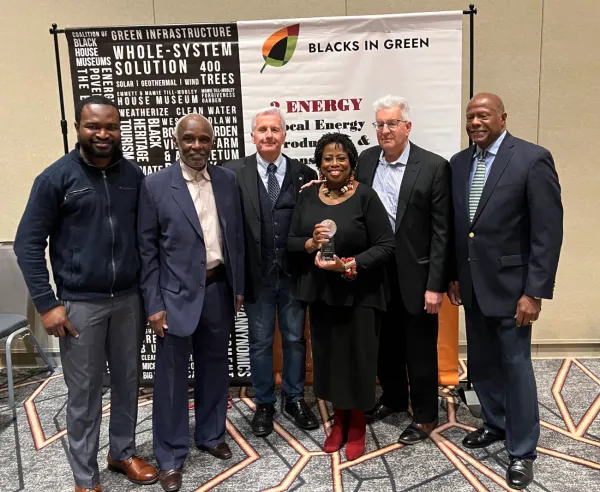
Renters, condominium owners, and homeowners unable to install solar will be co-owners of the solar co-op and accompanying profit sharing, and will have a voice in management. The co-op will also provide workforce training and capacity development, and present residents with a hands-on opportunity to help create an equitable clean energy transition that protects the environment in their own communities.
“This will ensure that the projects are completed and thereby demonstrate the power of solar sovereignty for ownership and wealth building by Blacks in distressed Black communities,” said Rev. Tony Pierce, GEJC board member and CEO of Sun Bright Energy, in a news release.
The co-op’s success in the Illinois Shines competition brings it one step closer to delivering the benefits of the burgeoning clean energy transition in Illinois to underserved and marginalized communities, which have suffered the double whammy of disinvestment and disproportionate detrimental impact of the effects of climate change.
“Given that many environmental justice communities like mine, in the far Southeast Side of Chicago, bear the brunt of climate change, this is a great opportunity to begin to undo and heal our communities from that harm,” said Olga Bautista, GEJC board member and co-executive director of the Southeast Environmental Task Force, in a news release.
GEJC is also supported by partners at Cooperative Energy Futures, a Minnesota-based member-owned clean energy cooperative that has developed similar models of equitable community ownership of solar projects.
“We’re really excited to be supporting GEJC in bringing community-owned solar to GEJC’s local communities in Illinois,” said Cooperative Energy Futures General Manager Timothy DenHerder-Thomas in a news release. “Through our co-op in Minnesota, we’ve seen the power of this model in uniting communities around a clean energy future that works for renters and low-income households and makes sure local residents own and get the benefits too.”
The three GEJC community solar projects selected by the Illinois Power Agency will be presented to the Illinois Commerce Commission, the Illinois public utility regulatory body, in January 2024 for final approval for renewable energy credit contracts.
While this award represents a substantial win, it only represents one piece of ongoing work for Blacks in Green, whose mission Davis sums up as the establishment of a “walk to work, walk to shop, walk to learn, walk to play village, where African Americans own the businesses, own the land, and live the conservation lifestyle.”
“We are determined to expand our clean energy businesses.” Davis said. “That means we’re working to get funding so that we can work closely with our neighbors to educate, engage, train, mobilize, finance, and otherwise support ourselves in the design and implementation of local living economies in energy, horticulture, housing, tourism, and waste.
“We are here to, for example, decarbonize all of the buildings in our Sustainable Square Mile of West Woodlawn. And that’s no small feat to decarbonize the walkable village at scale,” Davis continued, saying that residents need to undertake weatherization measures and other costs before taking full advantage of clean energy technology.
Blacks in Green’s mission also includes work on a virtual power plant and clean energy microgrid, affordable energy legislation, and geothermal power.
“So, we’re on the ground taking all of the access points to, along the way to creating a triumph for ourselves in the tradition of our great migration ancestors,” Davis said.
And while she recognizes the importance and even necessity of philanthropy, Davis has no intention of relying solely on donors.
“We are looking to be our own emergency management system. At the end of the day when the ‘you know what’ hits the fan, we want our communities, our walkable villages to be ready not only because they have greater health and wealth, but because they have been in the process of creating an oasis of resilience against the harms of the climate crisis” Davis said. “That’s what we’re here to do.”
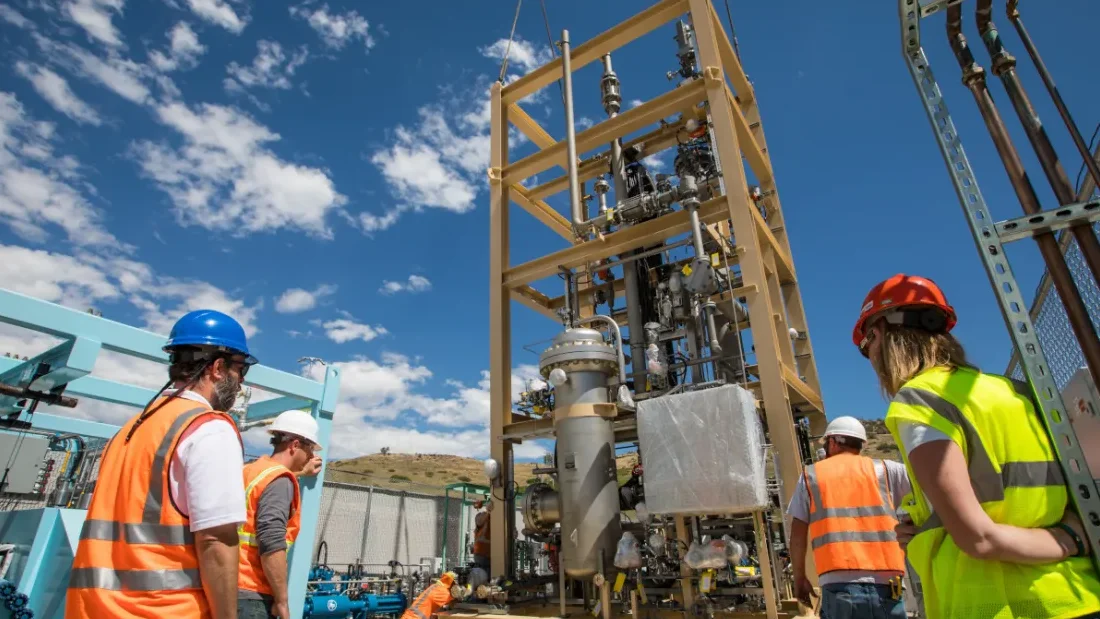
This story was produced in partnership with OpenSecrets, a nonpartisan, nonprofit organization that tracks money in politics. Jimmy Cloutier is the political reporter at opensecrets.org. He can be reached at jcloutier@opensecrets.org.
The number of companies and organizations lobbying the federal government on issues related to hydrogen increased nearly tenfold since President Joe Biden took office — from about two dozen at the end of 2020 to more than 200 this year, according to an OpenSecrets analysis of lobbying disclosures.
Fossil fuel companies, which have promoted hydrogen as a catch-all solution to climate change, rank among the top spenders and outnumber clients from every industry, including the renewable energy sector, the analysis shows.
Thirty-two oil and gas producers reported lobbying on hydrogen, among other issues, and spent a combined $41.3 million on federal lobbying efforts this year, as of Sept. 30.
The lobbying blitz comes as the Biden administration prepares to direct billions of dollars in federal subsidies to scale up hydrogen production to decarbonize the U.S. economy. Unlike coal, oil and gas, hydrogen does not release planet-warming greenhouse gases when burned.
The number of companies and organizations that reported lobbying on issues related to hydrogen has increased tenfold since President Joe Biden, who promised aggressive action on the climate crisis, entered office, according to federal lobbying disclosures.
.png)
Many climate advocates support this move but warn against incentivizing hydrogen projects that could prolong the use of fossil fuels.
It is possible to produce so-called “green hydrogen” using water and renewable energy, but about 95% of hydrogen is currently derived from natural gas, which generates large amounts of climate pollution.
The fossil fuel industry has aggressively lobbied the White House, Congress, and Energy and Treasury departments to ensure gas-based hydrogen qualifies for federal subsidies. The industry claims it can produce climate-friendly “blue hydrogen” from natural gas using carbon capture, a nascent technology still in early development.
In 2022, the American Petroleum Institute, which represents nearly 600 oil and gas companies, submitted comments on the Energy Department’s draft National Clean Hydrogen Strategy and Roadmap emphasizing the near-term cost advantages of blue hydrogen. The industry group’s climate action framework, published the previous year, also called for “full government funding” of low-carbon research and development programs and urged policy-makers to adopt a “technology-neutral” approach to the energy transition.
Julie McNamara, the deputy policy director for climate and energy at the Union of Concerned Scientists, a think tank, told OpenSecrets that the government risks “aiding and abetting fossil fuel” interests.
“There are so many ways that hydrogen can go that it just perpetuates the status quo,” she explained.
“That is an extremely lucrative place for the fossil fuel industry to be,” she said. “If we have weak standards, it can mean more use of natural gas for longer with more profit along the way.”
Climate advocates have urged the Biden administration to enact strict guardrails to ensure hydrogen projects deliver on their climate promises. They want the federal government to prioritize the development of green hydrogen and limit its use to heavy industries that cannot be electrified, like aviation and steel. They also emphasize the need to accelerate the buildout of renewable energy infrastructure to meet the demands of green hydrogen production, which requires a significant amount of electricity.
Getting hydrogen wrong, McNamara added, would be a “catastrophic waste of time.”
Thirty-two oil and gas companies reported lobbying on hydrogen, spending a combined $41.3 million on federal lobby efforts in the first nine months of 2023. Top spenders include several fossil fuel producers that stand to receive billions in federal funding to develop regional clean hydrogen hubs.

In response to interview requests from OpenSecrets, the American Petroleum Institute shared a study it commissioned “on the benefits of low-carbon hydrogen.” The study concluded that “uniform incentives” for blue and green hydrogen would lead to the fastest buildout of hydrogen infrastructure.
The American Petroleum Institute spent nearly $4.5 million lobbying the federal government in the first nine months of 2023.
Companies and industry groups report lobbying on dozens of issues, making it difficult to tell from disclosures how big a priority hydrogen was for oil and gas companies. But several leading fossil fuel producers — such as BP, Chevron and Exxon Mobil — have invested in hydrogen initiatives and made the alternative fuel source a key component of their low-carbon solutions programs.
The companies, which all reported lobbying on hydrogen, also stand to benefit from generous government grants and tax credits intended to phase out fossil fuels.
In October, the Energy Department announced plans to award $7 billion to seven proposed regional hydrogen hubs, including $1.2 billion to a Texas project that counts fossil fuel giants Chevron, Exxon Mobil, Phillips 66 and Shell as partners. BP and Exxon Mobil are also involved in developing a Midwest hub that will receive $1 billion through the same government program.
Three of the hubs awarded federal funding are expected to produce hydrogen from natural gas, according to press releases and publicly available information. The Texas hub will produce hydrogen from natural gas and a renewables-powered electrolyzer, while the Midwest hub will rely on a mix of natural gas, renewable energy and nuclear energy.
A third hub in Appalachia — spanning West Virginia, Ohio and Pennsylvania — will produce hydrogen entirely from natural gas. Project developers include Marathon Petroleum.
In response to requests for comment, a Chevron spokesperson told OpenSecrets that the company is “committed to working with policymakers to help inform well-designed energy policy that effectively reduces greenhouse gas emissions.”
A Marathon spokesperson said the company is seeking “clarity on upcoming regulations.” Other companies named in this article did not respond to requests for comment.
The reaction from climate advocates to the hub announcement was mixed.
“We expected there to be a little more green hydrogen,” said Erik Kamrath, hydrogen policy advocate at the Natural Resources Defense Council. He noted that the Bipartisan Infrastructure and Jobs Act of 2021, which authorized the awards, required only one project producing hydrogen from fossil fuels to be selected.
The awards are still subject to negotiations and environmental reviews, but McNamara said the Energy Department left the door open to “unproductive at best, actively harmful at worst” production methods that rely on natural gas and carbon capture.
“Hydrogen can drive up pollution from fossil-fuel-based uses, and worse, perpetuate ongoing use of fossil fuels,” McNamara said. “That’s not the path we need to be on.”
In an email to OpenSecrets, an Energy Department spokesperson said, “DOE’s Regional Clean Hydrogen Hubs program is essential to achieving the President’s vision of a strong clean hydrogen economy that creates healthier communities, strengthens energy security, and delivers new economic opportunities across the nation.”
The department, which environmental groups have criticized for its lack of transparency, did not answer emailed questions about the hydrogen hubs and instead directed OpenSecrets to online pages containing high-level overview of the agency’s hydrogen hub program and awards negotiation process.
Climate advocates and the fossil fuel industry are also squabbling over additional clean hydrogen tax credits authorized through Biden’s signature climate spending package, the Inflation Reduction Act, passed last year. The tax credit is worth up to $3 per kilogram for hydrogen produced using low-emissions processes.
Green hydrogen produced without fossil fuels is energy-intensive, and climate advocates want to limit the incentive to hydrogen produced using new, rather than existing, clean energy sources.
“We are in a renewables constrained environment,” said McNamara, explaining that if hydrogen production scales up too quickly and relies on existing renewable infrastructure then electricity providers may have to turn to fossil fuels to keep up with energy demands.
Some hydrogen producers and fossil fuel companies who support looser regulations argue that stringent requirements will slow development and delay the U.S. transition to clean energy.
Last week, Bloomberg and Politico reported that leaked draft rules on the tax credits indicated the Biden administration would require producers to rely on newly built renewable energy.
The Treasury Department is expected to formally issue a rule by the end of the year.

CLIMATE: Black Americans’ migration to the Southeast to escape environmental racism and poor health outcomes in the North and Midwest means a growing number of people are moving toward the epicenter of the climate crisis. (Capital B)
BIOMASS: Opponents of a wood pellet producer’s planned Alabama plant cheer reports the company is experiencing a financial crisis that could undercut its plans to expand. (Inside Climate News)
POLITICS:
SOLAR:
STORAGE:
WIND:
ELECTRIC VEHICLES:
NUCLEAR:
OVERSIGHT:
GRID:
UTILITIES: The Tennessee Valley Authority projects the need to boost power production due to rising demand from electric cars, data centers and overall economic growth. (Chattanooga Times Free Press)
COMMENTARY: Indiana should emulate Kentucky’s example and pass a law making it more difficult for utilities to close coal-fired power plants to ensure grid reliability, writes a Republican town council member. (Cleburne Times-Review)
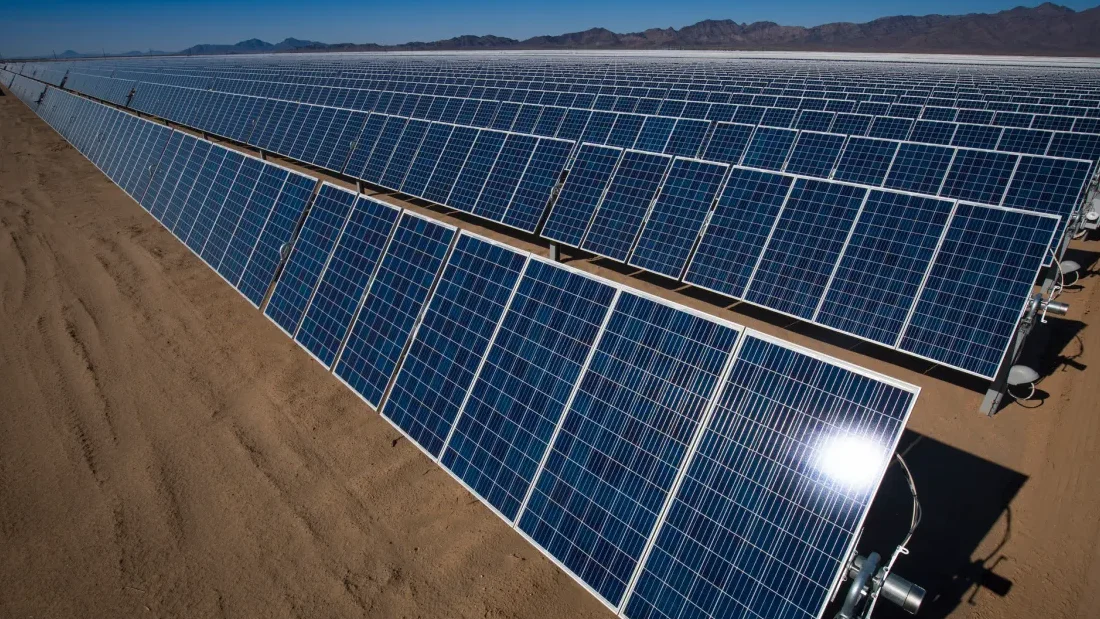
NUCLEAR: California regulators vote to allow the Diablo Canyon nuclear plant to continue operating for five years beyond its scheduled 2025 retirement date. (Associated Press)
OIL & GAS:
CLIMATE:
SOLAR: An Arizona solar panel installation firm ceases operations, lays off dozens of employees and files for bankruptcy. (Phoenix Business Journal, subscription)
TRANSPORTATION: An analysis finds California’s zero-emissions vehicle mandates and other climate programs could lead to a nearly $6 billion decrease in gasoline tax revenues and a shortage of highway repair funds. (CalMatters)
HYDROPOWER: Northwest tribal nations and environmentalists say their $1 billion salmon recovery deal with the Biden administration is a road map for dismantling hydropower dams. (Associated Press)
STORAGE: California’s energy commission awards a firm $30 million to build a long duration iron-air battery storage project near Mendocino. (news release)
UTILITIES:
WIND: A Washington state advisory council will decide next month whether to recommend approval of a controversial proposed 200-turbine wind facility near Kennewick. (Tri Cities Area Journal of Business)
COMMENTARY: California needs to stop bickering over the minutiae of net metering policy and cost-shifting and wholeheartedly embrace rooftop solar to tackle climate change, an energy journalist argues. (Los Angeles Times)

With the federal government preparing to pour money into new regional production hubs and other incentives, the hydrogen industry is positioning itself for takeoff.
But hydrogen technology still hasn’t proven itself to be financially viable, or necessarily all that clean. Hydrogen doesn’t produce greenhouse gas emissions when burned, but making the fuel requires lots of — potentially dirty — energy. Most of it today is made with natural gas. A clean alternative involves a process using water and renewable electricity, but some want to keep using natural gas but with carbon capture — another technology still unproven on a larger scale.
Climate advocates want to keep hydrogen made with fossil fuels from being lumped in with cleaner sources, and say it shouldn’t qualify for forthcoming federal subsidies. Meanwhile, fossil fuel companies and other blue hydrogen backers have launched a federal lobbying blitz in hopes of getting on the Biden administration’s good side, the Energy News Network’s collaboration with OpenSecrets reveals.
Just a few dozen companies and organizations were lobbying the federal government regarding hydrogen when President Biden was elected in late 2020, Jimmy Cloutier of OpenSecrets reports. Now, that number is more than 200, including at least 32 oil and gas producers.
That influence could all have an impact on forthcoming rules governing where federal hydrogen incentives will go, which are expected before the year ends.
Read more from the Energy News Network and OpenSecrets here.
🇺🇲 IRA’s foreign influence: While the Inflation Reduction Act continues to rankle Republican lawmakers, foreign leaders say its “green patriotism” and incentives for domestic clean energy manufacturing provide a blueprint for climate plans they can sell across the political spectrum. (New York Times, Politico)
🔌 EV chargers’ reliability problem: Today’s electric vehicle charging stations largely fall below reliability standards the federal government is requiring they meet before they can access $5 billion in new funding. (Canary Media)
🔋 What’s next for batteries: As more renewables are added to the power grid, researchers are exploring new battery technologies with longer storage durations and more widely available materials than lithium-ion batteries. (Utility Dive)
⚡ Electrification diet: A planning process known as “watt dieting” could enable many homeowners to switch to fully electric appliances without a costly panel upgrade. (Canary Media)
📰 Fake news, fossil fuel edition: At least seven major news outlets create and publish misleading advertisements for fossil fuel companies intended to look like credible editorial content, an analysis finds. (Intercept)
🏭 Stopping smog: A new federal air pollution rule cut smog-forming emissions 18% in 10 states this past summer, and would’ve had a bigger impact if legal challenges hadn’t stopped its implementation in 12 other states. (Grist)
The COP28 climate summit ended yesterday, after disagreements sent negotiations into overtime. Here’s how the U.S. got involved in the last week.

COAL: Appalachian Power considers what to do with the site of a Virginia coal-fired power plant that was shuttered in 2014, and whether it can transport accumulated coal ash there to a West Virginia landfill. (WVTF)
ALSO: Georgia Power presses to keep two coal-fired power plants open a decade longer than planned, despite one’s ranking in a recent study as the second most deadly polluter among U.S. coal plants. (Georgia Public Broadcasting)
STORAGE: Duke Energy disconnects large, Chinese-made batteries at a Marine Corps base in North Carolina after officials express security concerns about the manufacturer’s ties to China’s Communist Party. (Reuters)
SOLAR:
EFFICIENCY: Louisiana regulators prepare to vote on long-awaited energy efficiency rules to require utilities to implement various power-saving measures and technologies. (Louisiana Illuminator)
ELECTRIC VEHICLES:
OIL & GAS:
NUCLEAR:
GRID: A Democrat and a Republican newly elected to the Virginia legislature join a coalition to announce a new state advocacy group that will push for stronger oversight of the state’s booming data center industry. (Richmond Times-Dispatch)
CLIMATE: Florida struggles to deal with dramatically varying amounts of rainfall, from record deluges on its southeast coast to a drought along the Gulf Coast. (Associated Press)
UTILITIES: A columnist explains the confusing methodology behind how utilities pay North Carolina property taxes. (Asheville Watchdog)
COMMENTARY: